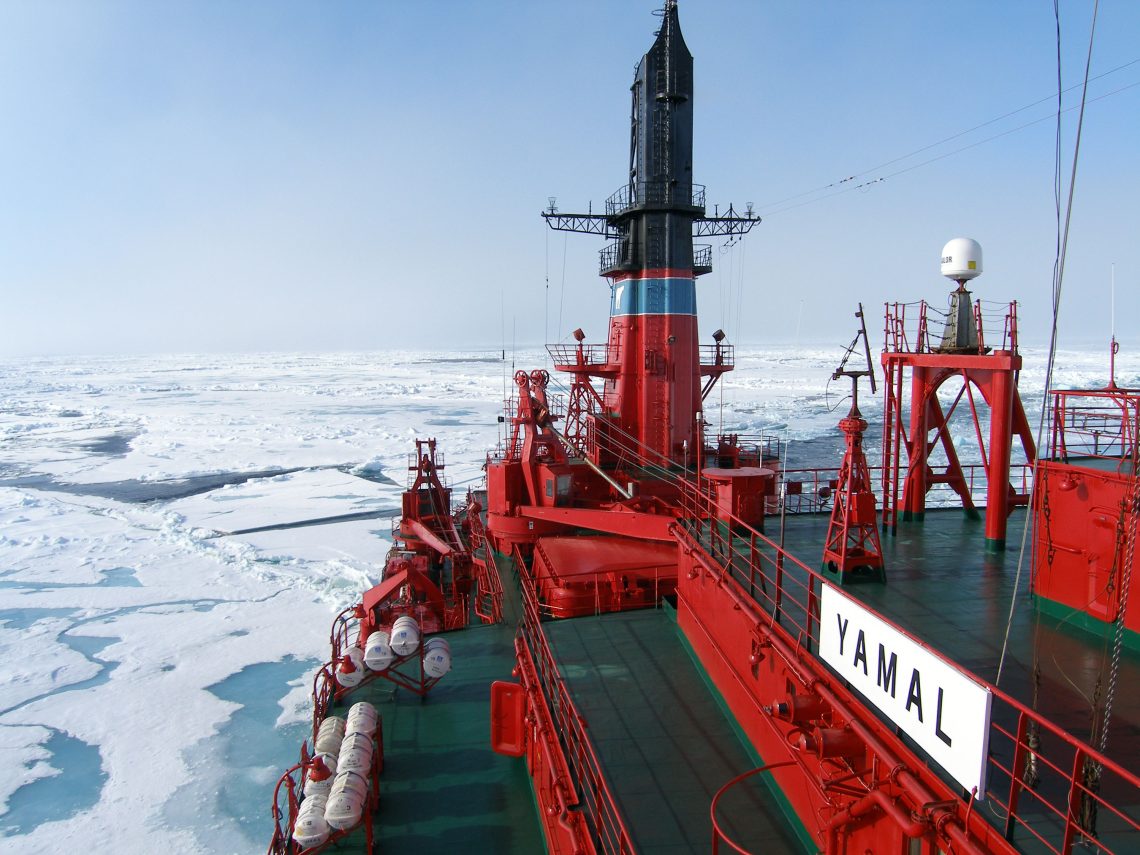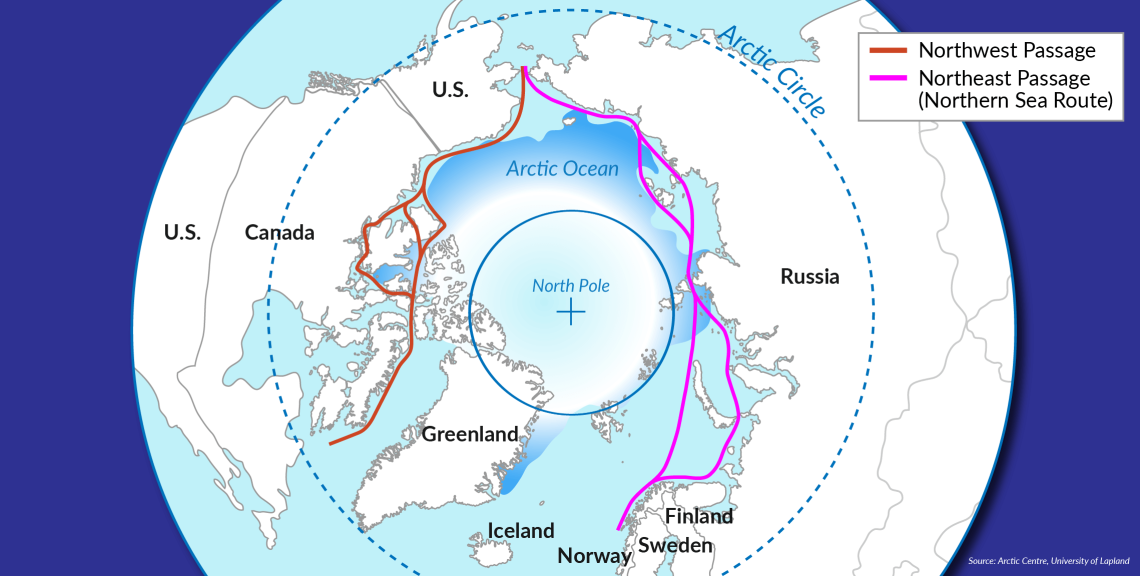All eyes on Russia’s Northern Sea Route
Warming temperatures and Asia’s appetite for Russian energy secure the future of shipping along the northern coast of Eurasia. But the West may not be part of it.

In a nutshell
- The choke points on today’s most-used shipping lines have become a problem
- The Northern Sea Route is turning more viable due to climate warming
- Russia, China and India, not Europe, may become the route’s dominant users
The missile attacks in the Red Sea provide a stark reminder of the vulnerability of commercial shipping. While prior threats, such as those from pirates off the coast of Somalia and in the Gulf of Guinea could be warded off by armed guards riding shotgun, the more sophisticated threat from Iran-backed Houthi terrorists has called for the deployment of serious naval assets. These developments provide insights into how the logic of commercial interests is being trumped by geopolitical tensions.
The supply lines and choke points
The opening of the Suez Canal was a historic event that transformed global logistics. Ever since its completion in 1869, it has been the favored route for shipping from Europe to Asia, allowing ships to avoid the lengthy detour around the continent of Africa. The downside is that these savings do not come without risks.
The broader lesson of the recent Red Sea events is that the global flow of goods can be held hostage via critical choke points that determined actors may interdict. The Suez Crisis in 1956 provided an early illustration that threats to the ownership of critical real estate can provoke war. When Egyptian president Gamal Abdel Nasser nationalized the Suez Canal Company, which had been controlled by French and British interests, France, Britain and Israel responded with military intervention.
The canal zone itself is not the only vulnerability on this vital route. To the south, the narrow Strait of Bab el-Mandeb separates Africa from the Arabian Peninsula. That is where Somali pirates emerged as a key player and where Houthi terrorists operating out of Yemen began threatening shipping by laying sea mines.
Taking the Northern Sea Route was long practically impossible due to the thick sea ice laced with impenetrable ridges.
A choke point of similar importance is the Strait of Hormuz, which offers the only passage for tankers out of the Persian Gulf. As tensions between Iran and the West have escalated, it has become a significant global flash point. By moving to block it, Iran (or its proxies) could cause a global energy crisis that could then translate into a kinetic war.
Further to the east, China has long been aware of its own vulnerability, as the United States Navy may interdict its energy supply from the Persian Gulf at the Strait of Malacca. A total blockage could stop 80 percent of the Middle Kingdom’s crude oil imports. As in the case of a Strait of Hormuz blockage, it would inevitably produce a flashing red alert.
Even short of such outcomes, the mounting risks of prolonged disturbances at various choke points hurt shipping by increasing uncertainty and insurance costs.
Enter the northern route
The combined impact of all these developments has been to shed new light on the Northern Sea Route (NSR), which links Europe with Asia via the Arctic Ocean.
Facts & figures
Map of the Northern Sea routes

While the distance from Rotterdam to Yokohama via the Suez Canal Route is about 21,500 kilometers, it shrinks to only 11,900 kilometers via the Northern Sea. The time of passage – a critical factor in determining the efficiency of shipping routes – is in this case reduced by close to half.
Taking the Northern Sea Route was long practically impossible due to the thick sea ice laced with impenetrable ridges. However, as climate change has caused the Arctic ice cover to recede, new opportunities have surfaced.
Read more on global supply chain challenges
- Panama, China and the Canal
- The Suez Canal privatization conundrum
- China’s strategic evolution in the Middle East: From oil to security
- Energy security: Perceptions versus realities
If it were a purely commercial decision, a massive wager on this route would have been a foregone conclusion. The commercial argument received an added boost in March 2021, when a stranded container ship blocked the Suez Canal for six days, holding up to 400 vessels in place and causing massive economic losses. To Western countries, however, the northern seaway is far from a purely commercial matter.
Promising plans
Up until the Russian full-scale invasion of Ukraine in early 2022, the commercial argument could carry the day. Both Russia and China had invested heavily in boosting traffic along the NSR, including the construction of nuclear-powered ice breakers and cargo ships with reinforced hulls to sail through ice.
The driving force was the shrinking ice cover, which allowed the window for possible passage to expand steadily. Between 1980 and 2020, the extent of sea ice during August and September, when the ice cover tends to melt to a fourth of its size in winter, was roughly cut in half. In the latter year, the NSR was open for a record 88 days, from August 2 until October 28. The prior peak was marked in 2012, at 69 days.
Many different shipping companies were making plans for further developments. The war against Ukraine changed all this.
The result was a rapid growth in traffic. Having never exceeded 5 million metric tons annually, the flow of cargo began to surge in 2015, reaching 33 million metric tons in 2020. In 2022, the traffic was reported at an all-time annual high of around 34 million metric tons, showing continued growth despite geopolitical challenges. Inspired by these numbers, in August 2022, the Russian government signed off on a comprehensive $29 billion development plan for the NSR.
The plan was ambitious, envisioning that by the year 2035, the total volume of traffic would reach 240 million metric tons, representing a sevenfold increase from the record high of 2022. The short-term goal was to increase the volume to 80 million metric tons already by 2024. In addition to investing in developing the sea lanes, Russia also applied to the United Nations for recognition of the seabed outside its Exclusive Economic Zone as part of its continental shelf.
When relations between Russia and the West were open to economic cooperation, many different shipping companies were making plans for further developments. The war against Ukraine changed all this. As Western partners walked away, traffic took a nosedive. Paradoxically, however, the Western sanctions have caused a rebound, setting an important pattern for the route’s future.
A boon to Russia’s energy business
At the time of the 2022 invasion, Russia exported about 400,000 barrels of crude oil per day to Northern Europe. By the end of that year, that flow had dried up while exports to Asia reached 300,000 barrels per day. During 2023, as crude oil shipments from the Baltic Sea to China were rerouted from the Suez Canal Route, the Northern Sea Route recorded a new record volume of transit cargo. Out of a total volume of 2.1 million metric tons that made the full transit across the frigid northern waters, 1.5 million metric tons was crude oil from the Baltic Sea.
The main lesson from this boost in traffic concerns the changing nature of the cargo flows. The Russian development plan envisioned that the bulk of the cargo would be hydrocarbons. As non-Russian shipping companies walked away, that pattern became dominant. In 2023, the total volume of freight set a record of 36 million metric tons, more than half of which was liquefied natural gas (LNG) shipped both to Europe and to Asia. The latter explains the difference between the respective volumes of transit cargo and total cargo.
The core part of the Northern Sea Route stretches along the Russian Arctic seaboard from Murmansk to the Bering Strait. Transit traffic is cargo between Europe and Asia that passes both ends of this stretch. That is now only a small part of the total. The bulk is traffic that emanates in Russia and is taken to either Europe or China. Although crude oil from Arctic fields does play a part, the primary source of this trade is LNG produced on the Yamal Peninsula by the Russian private energy company Novatek.
Russia has already begun building a ‘shadow fleet’ of decrepit old tankers with unknown owners that flout all established maritime rules.
When Russia’s national gas giant Gazprom placed a losing bet on pipelines, Novatek invested in developing LNG and scored. China played an important supportive role already before the imposition of sanctions, assuming ownership stakes in Novatek projects. As the West sanctioned Russia’s energy interests, China has continued providing vital inputs for those projects. As late as April 2024, delivery of a 14th prefabricated plant module allowed Novatek to complete the construction of a second production unit for its Arctic LNG plant located on the Gydan Peninsula in Western Siberia, Russia. The project aims to export gas from Novatek’s Salmanovskoye and Geofizicheskoye fields, with a planned yearly capacity of 19.8 million tons across three production lines.
Much of this LNG goes to Europe, which has stopped short of sanctioning Russian gas. Until recently, some volumes were even exported to Europe for transshipment to other destinations, creating an expanding market for Russia, which has now become the fourth-largest exporter of LNG in the world. The associated rapid expansion of shipping under sanctions has a severe downside.
Floating time bombs
Seeking to circumvent sanctions on its oil exports, Russia has already begun building a “shadow fleet” of decrepit old tankers with unknown owners that flout all established maritime rules. Sweden and Denmark have voiced concerns about the danger of major environmental disasters as these uninsured and poorly maintained single-hull tankers move along their coasts. Ships from this sizable fleet have been tracked moving into the Arctic.
Buyers with suspected ties to Russia have now also begun acquiring old tankers for the transport of LNG. Allowing such ships, which lack any meaningful protection against sea ice, to become part of Arctic shipping poses a looming threat of environmental damage.
Scenarios
Looking forward, two scenarios emerge with very different geopolitical implications. One assumes that the conflict in Ukraine is resolved before long and commercial interest in the Northern Sea Route returns, ramping up traffic. Avoiding the mounting risks at choke points along the Suez Canal Route proves even more critical to shipping companies than saving time. The other script is based on the war remaining extended indefinitely.
Both these scenarios stem from the forecasted increase in global demand for LNG. This will spur the development of Russian energy projects in the Arctic. Foreign companies will be eyeing these developments and wanting a piece of the action. Aside from the commercial gain, a cooperative international approach to energy and logistics would also have a positive impact on worsening Arctic security.
There are some caveats to that vision of quick development of the Northern Sea Route. Although the outlook suggests continued shrinkage of the ice cover, a long-term investment strategy will have to factor in the possibility of a reversal of this trend. Another caveat is that even if warming continues, Arctic weather will remain unpredictable, meaning that conducting traffic based on shipping schedules that cater to “just in time” demand will not be feasible. There is also the question of the high costs of investing in vessels with proper ice class and infrastructure for sea rescue and other forms of support.
Yet, no factor will define the Northern Sea Route’s commercial and geopolitical future more than an indefinite extension of the war in Ukraine.
Most likely: The West keeps out
If Western sanctions remain or are tightened, its companies, including those in Japan and South Korea, will stay away. The consequences for Russia are already being felt.
The envisioned expansion of traffic along the Northern Sea Route to 80 million metric tons for 2024 is likely to stop at 40 million metric tons, in part due to the delays in the launch of Novatek’s LNG-2 project. As American sanctions are zooming in on the LNG projects, and as China becomes increasingly wary of secondary sanctions, Russia is looking for domestic demand alternatives, but that avenue is not very promising.
Under this most likely scenario, relations between Russia and China are strengthened by a shared interest in developing Arctic energy resources, and relations between India and China will continue growing closer, also driven by common interests. Like China, India is receiving large volumes of Russian oil at a heavy discount, and Indian investors are being courted for investment in Russian energy projects.
A tighter alliance between Russia, China and India that is based on the latter two exploiting Russia as a secure source of cheap energy will have negative implications for security beyond the Arctic.
Likely: Increase in ‘shadow fleets’
An alliance between these three powers will also produce a mounting threat to global maritime rules and regulations.
Russia’s vision of expanding its fleet of icebreakers and ice-class vessels ran into trouble already in 2022 when Finnish companies exited the project. More recently, South Korea has also either canceled or put on hold a planned delivery of six LNG tankers to Novatek. The consequence is a rapid growth in the “shadow fleet” of tankers.
Shadow fleet ships flout the demands for insurance and safety inspections and avoid detection by sailing with their transponders turned off. They make port only in the three partnering countries, and as China and India show little interest in investing in the fleet’s safety, a likely corollary outcome is that shipowners in other countries will also engage in lucrative trade with such vessels. Major sea accidents are bound to occur.
For industry-specific scenarios and bespoke geopolitical intelligence, contact us and we will provide you with more information about our advisory services.







